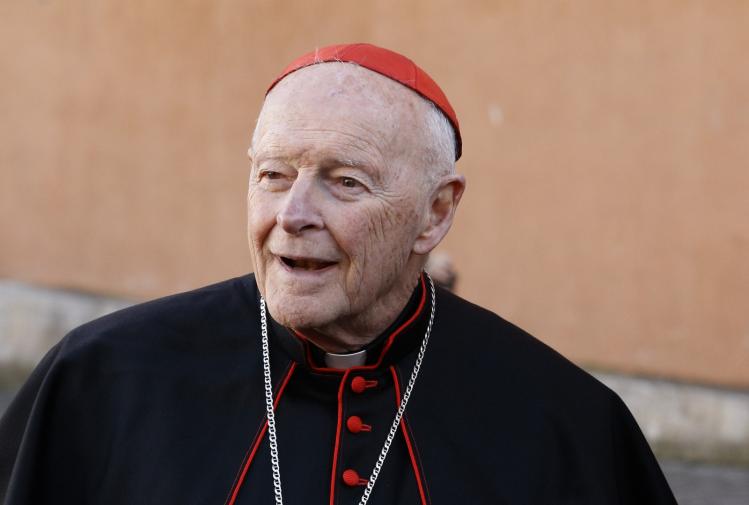
Emerging details about the scope and duration of Cardinal Theodore McCarrick’s sexually abusive behavior once more underscore the fact that an institutional sickness afflicts the Catholic Church. A predator priest can ascend to princely rank only if the clerical culture around him enables those who are complicit by their silence and failure to act.
The behavior of “Uncle Ted,” as the cardinal insisted he be called by his preferred victims, was something of an open secret at elite levels of the church. As the New York Times noted, multiple reports about McCarrick’s sexual encounters with seminary students were made between 1994 and 2008—to American bishops, to the pope’s representative in Washington, and even to Pope Benedict XVI. Two dioceses secretly made settlement payments to alleged victims. This didn’t slow a swift rise: McCarrick became a global ambassador dispatched to conflict zones, a prolific fundraiser, and the honoree of numerous Catholic institutions eager to present him with awards. He even played a prominent role as a spokesperson for the church’s “zero-tolerance” policy on sexual abuse.
The causes of clerical abuse are complex and multilayered. Some Catholic conservatives and others on the right seem not to take this sufficiently into account. [*] First Things senior editor Matthew Schmitz recently tweeted: “It will be impossible to address sexual abuse in the Church if bishops and priests do not clearly affirm the Church’s teaching on sex, including same-sex activity. Treating affirmations of that teaching as uncivil, unhelpful, or distracting risks making things worse.” And then there was this from Matt Walsh (@MattWalshBlog): “The pedophile scandal in the Catholic Church is not a pedophile scandal. The vast majority of victims are post-pubescent teens and young men. The real problem in the Church that everyone sees and few will say out loud: gay priests.”
This is an agenda in search of facts. A 300-page report, prepared by researchers at the John Jay College of Criminal Justice at the request of the U.S. bishops seven years ago, found no statistical evidence that gay priests were more likely to abuse minors. What’s more, researchers found that the uptick in the number of gay priests from the late 1970s corresponded with “a decreased incidence of abuse-not an increased incidence of abuse.” The disproportionate number of adolescent male victims, according to the report, was linked to opportunity, not to preference or pathology.
A witch-hunt mentality demonizes the vast majority of celibate gay men who are faithful to their vows, serve the church, and are as horrified as anyone at the abuses committed. The need to reject stereotypes and call out homophobia doesn’t mean that all discussion about homosexuality in the priesthood is off the table. As veteran Vatican observer Robert Mickens recently argued in the Washington Post, the closet is part of the problem:
There is no denying that homosexuality is a key component to the clergy sex abuse (and now sexual harassment) crisis. With such a high percentage of priests with a homosexual orientation, this should not be surprising. But let me be very clear: psychologically healthy gay men do not rape boys or force themselves on other men over whom they wield some measure of power or authority. However, we are not talking about men who are psychosexually mature. And yet the bishops and officials at the Vatican refuse to acknowledge this. Rather, they are perpetuating the problem, and even making it worse, with policies that actually punish seminarians and priests who seek to deal openly, honestly and healthily with their sexual orientation.
If the church removed all gay priests from ministry today, it would suffer for that loss. Nor would it bring an end to the abuse crisis. The problem is with those bishops, and others with influence in the church, who at best are asleep at the wheel and at worst willing to excuse predatory behavior. Boston Cardinal Sean O’Malley this week acknowledged a “major gap” in procedures for how the church deals with a bishop or cardinal accused of abuse, and called for specific new steps. “Failure to take these actions will threaten and endanger the already weakened moral authority of the Church and can destroy the trust required for the Church to minister to Catholics and have a meaningful role in the wider civil society,” he said. There were plenty of red flags about McCarrick, more than enough to stop his ascent into the College of Cardinals. That it was nevertheless allowed to proceed is an institutional failure on a massive scale. No scapegoating will make this mess go away.
And no single step—ending celibacy requirements or allowing priest to marry—will serve as a panacea. The significant spike in abuse cases in the 1960s and 1970s, the John Jay researchers found, had much to do with psychologically unhealthy priests who were not properly screened, and who became clergy at a time when seminary education lacked a focus on psychological-emotional development. Improved seminary training and education in the 1980s, according to the report, contributed to a “sharp and sustained decline” in abuse cases since then.
This suggests the need for continued, practical work on this front. More important is changing a clerical culture that prizes secrecy and loyalty over truth and transparency. That will be tedious, challenging and essential work. In the ongoing wake of the McCarrick scandal, it’s time to take up that task with greater urgency than ever.
[*] This post has been updated with a clarification.


